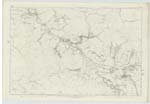OS1/3/21/62
| List of names as written | Various modes of spelling | Authorities for spelling | Situation | Description remarks |
|---|---|---|---|---|
| MOTE [Dalmellington] | Moat Moat Moat Moat Moat Moat |
- William Walker Esqr Bells Bank Revd. [Reverend] William Gilchrist Mr. William G. Galloway Mr. Robert Smith Johnston's County Map |
046 | A very prominent Circular green Knoll at the top of the village of Dalmellington about 24 feet high above the general Surface, its base diameter is about 140 feet, it is quite flat on the top with a diameter of about 60 feet, the Sides though grassy are quite Steep, it would appear that it was defended by a dry ditch of about 10 or 12 feet wide a part of which is now defaced. Tradition is Silent as to the date or object of its erection but all agree that it was connected with the neighbouring Castle, it Commands a view of the whole of the village and is the favourite evening resort of the Villagers the property of the Hone. [Honourable] F. M. Cathcart Berbeth |
Continued entries/extra info
[Page] 62Dalmellington Parish -- Sheet 46 -16
F.E.P. [Francis Edward Pratt]
Lieut. R.E. [Lieutenant Royal Engineers]
"An interesting remain of baronial power is pointed out in the beautifully rounded
"and terraced mothill, or justice seat, which still exists in nearly the same condition as when
"the law was promulgated to the assembled inhabitants from its summit. It is situated
"at the head of the village, between the houses and the site of the castle, and commands an
"excellent view of the strath of the Doon for several miles. It is generally believed that these
"mots were first used when the feudal system was introduced; but the probability is that
"they were older. We know that the Brehon law of the Scots, if not of the ancient Picts or
"Britons, was administered in a similar manner in the open air. The Gaelic mod, or court
"of justice is clearly the Lowland mot, to which the Saxon word hill being added, we
" have the mot-hill, or hill of justice. The oldest mound of this kind, of which we have
" any record, is the mute-hill of Scone, as it was written of old; believed to have been used
"for the promulgation of laws and the administration of justice by Malcolm Canmore. It is
" mentioned in the Leges Malcomi, which though held to be a fabulous work, is nevertheless
" indicative of the antiquity of the mot-hill of Scone. These hills were mostly artificial,
" or, at least, partly so; and being composed of excellent mould, maintained a green appearance
" rich in colour, and striking in form".
Patterson's History of Ayrshire (1847)
Transcribers who have contributed to this page.
Chr1smac -Moderator, hillhere
Location information for this page.
Linked mapsheets.




